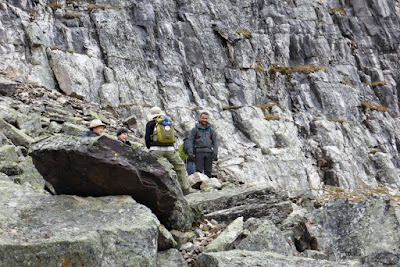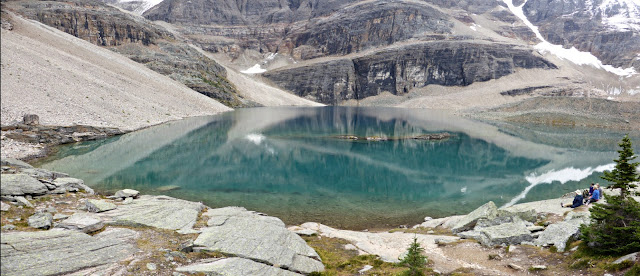 |
| Looking back at the last intersection. |
At first the trail was wide and low, passing Mary Lake, and then began to gently climb.
The route emerged from the forest and started scaling the edge of Opabin.
The view opened up immediately, an advantage the West Opabin trail holds over the East. We saw at least one pika on this climb, and heard others.
Flagstones led the way after the trail crested, a short distance beyond the All Souls and Opabin Prospect intersections.
Following this trail, we reached the bridge at the head of the Cascade Lakes.
The view looking further south.
Ducks landed in the lakes and began diving and bobbing for food.
Through our binoculars we could see that hikers had reached All Souls Prospect.
Joan and I crossed the bridge and headed north, to catch the start of the Opabin Highline trail. Up on the Highline we had a close pika sighting.
The larches were yellower than down below.
We followed the trail past Hungabee Lake to the East Opabin trail,
not far from its junction with the Yukness Ledges route.
So far we had only one glimpse of anybody else! But three hikers were waiting at the Yukness Ledges intersection for something or somebody. Joan and I went up and up through the boulder field initiating Yukness, happy to traverse it headed up rather than down, and at the start of the ledges for a change. We paused at the foot of the less than unofficial route to Sleeping Poets Pool, but deferred to uncertain weather and left that for another visit. The view down to the Opabin Plateau was gratifying.
We sat on a suitable rock and ate lunch; now we were starting to meet hikers headed in the opposite direction. Lake O'Hara came into view as the trail bent around the slopes of Yukness mountain.
More hikers, including a Parks Canada ranger, came along headed the other way. Joan was excellent in dispensing advice and enthusiasm for O'Hara to those on the ledges for the first time.
She also spotted some intriguing seams and inclusions on one rock face.
Vigilance pays off. As the Huber Ledges came into view,
Joan spotted a mountain goat in the distance, our first of the visit. It settled down for a rest.
We reached the Victoria Lake cutoff and decided to keep going to Lake Oesa. Some of the hikers we now encountered seemed ill-equipped for the stony trail, wearing running shoes and such; at least, that was our opinion. Two guys posed us a difficult question: whether the Yukness Ledges are best described as carefully-picking-you-way, or a more even, if narrow, trail. The correct answer is "both!" We did tell them about the cutoff in case they decided early on that the ledges were not to their liking.
We stopped at Lake Oesa, but only to put on rain gear because weather was blowing in with disappearing views. Fortunately it never grew bad; a few ice pellets and some rain, just enough to force me to alternate keeping the hood of my rain jacket up versus down. We marveled at the turquoise color of Lake Lefroy under these conditions.
On reaching the O'Hara lakeshore Joan and I experienced a keyhole in the clouds that that sequentially allowed the sun to illuminate the Opabin bluffs,
Mount Yukness,
the Seven Veils waterfall at the far end of O'Hara,
and a stretch of cabins.
Today there was no bat in the cabin waiting for us. After another superb dinner at the lodge, Joan and I began mapping out alternatives for tomorrow, depending on the weather. We knew we could not predict it in advance.
The view opened up immediately, an advantage the West Opabin trail holds over the East. We saw at least one pika on this climb, and heard others.
 |
| Looking back at Mary Lake. |
Following this trail, we reached the bridge at the head of the Cascade Lakes.
Ducks landed in the lakes and began diving and bobbing for food.
Through our binoculars we could see that hikers had reached All Souls Prospect.
Joan and I crossed the bridge and headed north, to catch the start of the Opabin Highline trail. Up on the Highline we had a close pika sighting.
The larches were yellower than down below.
We followed the trail past Hungabee Lake to the East Opabin trail,
not far from its junction with the Yukness Ledges route.
So far we had only one glimpse of anybody else! But three hikers were waiting at the Yukness Ledges intersection for something or somebody. Joan and I went up and up through the boulder field initiating Yukness, happy to traverse it headed up rather than down, and at the start of the ledges for a change. We paused at the foot of the less than unofficial route to Sleeping Poets Pool, but deferred to uncertain weather and left that for another visit. The view down to the Opabin Plateau was gratifying.
We sat on a suitable rock and ate lunch; now we were starting to meet hikers headed in the opposite direction. Lake O'Hara came into view as the trail bent around the slopes of Yukness mountain.
More hikers, including a Parks Canada ranger, came along headed the other way. Joan was excellent in dispensing advice and enthusiasm for O'Hara to those on the ledges for the first time.
She also spotted some intriguing seams and inclusions on one rock face.
Vigilance pays off. As the Huber Ledges came into view,
Joan spotted a mountain goat in the distance, our first of the visit. It settled down for a rest.
We reached the Victoria Lake cutoff and decided to keep going to Lake Oesa. Some of the hikers we now encountered seemed ill-equipped for the stony trail, wearing running shoes and such; at least, that was our opinion. Two guys posed us a difficult question: whether the Yukness Ledges are best described as carefully-picking-you-way, or a more even, if narrow, trail. The correct answer is "both!" We did tell them about the cutoff in case they decided early on that the ledges were not to their liking.
We stopped at Lake Oesa, but only to put on rain gear because weather was blowing in with disappearing views. Fortunately it never grew bad; a few ice pellets and some rain, just enough to force me to alternate keeping the hood of my rain jacket up versus down. We marveled at the turquoise color of Lake Lefroy under these conditions.
On reaching the O'Hara lakeshore Joan and I experienced a keyhole in the clouds that that sequentially allowed the sun to illuminate the Opabin bluffs,
Mount Yukness,
the Seven Veils waterfall at the far end of O'Hara,
and a stretch of cabins.
Today there was no bat in the cabin waiting for us. After another superb dinner at the lodge, Joan and I began mapping out alternatives for tomorrow, depending on the weather. We knew we could not predict it in advance.











































